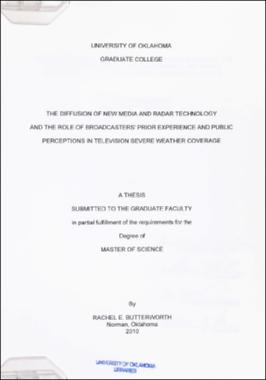| dc.description.abstract | Broadcast meteorologists are the top source of information for people during severe weather in the U.S. (Hayes, 2009; Legates & Biddle, 1999; Schmidlin & King, 1997; Sherman-Morris, 2009) and play an important role in disseminating life-saving information to the public. However, few studies have looked at their role as a communicator, the challenges they face when covering severe weather, and gathered their input on research topics pertaining to public understanding that are salient to them. Twenty broadcast meteorologists from various sized TV markets and positions in the central U.S. were interviewed in the summer and fall of 2009. Semi-structured interviews were used to gather insight on three topics: 1) How do broadcasters use experience to cover severe weather? 2) How are innovations such as new media, dual-polarimetric (dual-pol) radar and 3OVar (a small-scale wind analysis tool) being diffused in the broadcast industry? 3) How do broadcasters understand public perceptions and what questions would they like researchers to address related to public understanding, interpretation, and action during severe weather? Results were analyzed thematically and according to the theories of sensemaking (Weick, 1995) and diffusion of innovation (Rogers, 1976).
Various conclusions are derived from the results. First, broadcasters use insight gained from experience to make decisions during many severe events. However, their coverage is based on aspects of sensemaking when an unusual event occurs. Second, the use of new media in severe weather coverage varied from station to station, although the National Weather Service (NWS) Chat, internet simulcasting, and radio simulcasting were the most popular new tools. Some of the participants looked forward to the benefits of dual-pol radar, but were waiting for the NWS to lead a training initiative. Some broadcasters also found 3DVar to be useful but cautioned that it would have to be suitable for TV in order for them to show it on-air. Diffusion of innovation applied to the broadcasters' adoption of these tools. Relative advantage was the most common innovation attribute for an innovation that was farther along in the diffusion process (i.e. new media) whereas opinion leaders played a very important role for an innovation in the beginning stages (i.e., dual-pol & 3DVar). The data reveal a unique double-diffusion process. Not only were broadcasters concerned that the innovations were useful to themselves (i.e. user), but they were also concerned that the innovations were useful to viewers (i.e. customer). Resource limitations and lack of awareness of the benefits for the user, and complexity for the customer, were the most common barriers to adoption. Finally, most of the participants said there is a need to research topics related to public understanding and interpretation of weather information. Broadcasters would like specific feedback from viewers pertaining to topics ranging from the terminology they use, to radar and graphics, to overall coverage preferences. They would also like answers to the following questions: who is taking action, when do people take action, and why do they take action. Broadcasters are relying on the research community to address these questions. | |
